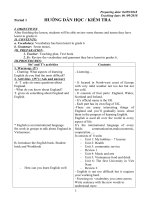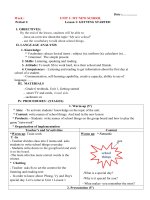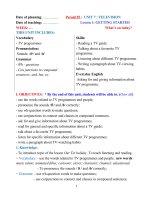Giáo án tiếng anh 7 sách global success kì 2
Bạn đang xem bản rút gọn của tài liệu. Xem và tải ngay bản đầy đủ của tài liệu tại đây (15.79 MB, 559 trang )
GIÁO ÁN TIÉNG ANH 7 KÌ 2
SÁCH GLONAL SUCCESS
UNIT 7: TRAFFIC
Lesson 1: Getting started – Meeting in the school yard
I. OBJECTIVES
By the end of this lesson, Ss will be able to gain:
1. Knowledge
- An overview about the topic Traffic
- Vocabulary to talk about means of transport
2. Core competence
- Develop communication skills and cultural awareness
- Be collaborative and supportive in pair work and teamwork
- Actively join in class activities
3. Personal qualities
- Develop awareness of travelling in town/city
- Be concerned to the local traffice
II. MATERIALS
- Grade 7 textbook, Unit 7, Getting started
1
- Computer connected to the internet
- Projector/ TV/ pictures and cards
- sachmem.vn
Language analysis
Pronunciati
on
Form
Vietnamese
equivalent
Meaning
1. cycle (v)
/ˈsaɪkl/
to ride a bike/bicycle
đạp xe
2. traffic jam
(n.phr.)
/ˈtræfɪk
dʒæm/
a line of vehicles waiting behind
something that is blocking the road
tắc đường
3. cross the road
(v.phr.)
/krɒs ðə
rəʊd/
pass the road
băng qua đường
4. rush hour
(n.phr.)
/ˈrʌʃ aʊə(r)/
the time, usually twice a day, when the
roads are full of traffic and trains are
crowded because people are travelling to
or from work
giờ cao điểm
Assumptions
Anticipated difficulties
Solutions
2
- Students may not be able to recognise - Give specific examples and ask
means of transport and have experience questions to activate students’
of using them on the road.
knowledge.
- Students may not know how to work in - Give short, clear instructions and help if
teams.
necessary.
Board Plan
Date of planning:……/……./2023.
Date of teaching:……/……./2023.
Unit 7: TRAFFIC
Lesson 1: Getting started – Meeting in the school yard
* Warm-up: Miming game
I. Vocabulary
1. cycle (v) /ˈsaɪkl/: đạp xe
2. traffic jam (n.phr.) /ˈtræfɪk dʒæm/: tắc đường
3. cross the road (v.phr.) /krɒs ðə rəʊd/: băng qua đường
4. rush hour (n.phr.) /ˈrʌʃ aʊə(r)/: giờ cao điểm
II. Practice
3
Task 1: Read the conversation and choose the correct answer.
Task 3: Write one word from the conversation to complete each sentence.
Task 4: Look at the pictures and write a word under each.
Task 5: Game: Find someone who …
* Homework
III. PROCEDURES
Notes:
In each activity, each step will be represented as following:
*
Deliver the task
**
Implement the task
***
Discuss
**** Giving comments or feedback
Stage -Stage aim
Procedure
- Warm-up
Miming game
- To activate students’
knowledge on the topic of the
* Teacher gives instructions
** In groups, Ss
4
unit
- To enhance students’ skills of
cooperating with team mates
- One of the students in the group go to the board.
- Teacher secretly show 1 picture of a mean of transport
to that student. He/She has to mime the picture and the
other has to guess. Of course the other groups will also
be allowed to guess.
- take turns go to the board until finish all the pictures.
**** Teacher checks and corrects if Ss pronounce the
words incorrectly.
Vocabulary - pre-teach
To help students use key
language more appropriately
before they read and listen
* T asks Ss to look at the photos and answer the
question
1. What is he doing?
2. What is this?
5
3. What are they doing?
4. Which time of the day usually has traffic jam?
** Ss say the words.
**** Teacher shows and says the words aloud and asks
Ss to repeat them.
* Teacher asks Ss to translate the word into Vietnamese.
Concept check: Slap the board
6
Lead-in/ pre-read and listen
Task 1. Exercise 2 (p.74):
- To get students interested in
the topic
* Teacher asks Ss to look at the picture (p.73), answer
the question:
- To set the context
+ Where are they?
- To help Ss understand the
main idea of the text
Read the conversation
again and choose the
correct answer:
1. How does Lan often go to
school?
A. By bicycle.
B. By motorbike.
C. On foot.
2. It normally takes Lan ___
to get to school.
A. two minutes
B. ten minutes
C. twenty minutes
3. Lan and Mark agree to go
cycling ______.
7
A. tomorrow
B. every day
C. at the weekend
** Ss work out and answer questions in pairs.
*** Ss share their answers as a whole class.
**** T asks them to read and listen to the conversation
to check their answers. T encourages students to explain
where they have found the answers from the
conversation.
Controlled practice
- To practise reading and
listening for specific
information
- To practise scanning
Task 2: Exercise 3 (p.74): Write one word from the
conversation to complete each sentence.
1. Last Sunday afternoon, Lan ______ round the lake near
her home.
2. Mark says to Lan: “You ______ be careful, especially
when you cross
8
the road.
3. Traffic ______ are a problem in big cities.
4. – ______ does your mum go shopping?
– She often walks.
5. This road is very ______ during the rush hours.
- To develop Ss' knowledge of
vocabulary
* Teacher asks Ss to work individually to read and listen
to the conversation and find the words and phrases and
then share their answers with their partners who sit next
to them. (peer check)
** Ss do exercise 3 individually
*** Ss share and discuss with their partners to write all
words/ phrases down on the notebooks.
**** Teacher corrects their answers as a class.
Answers
1. cycled
2. should
How
5. crowded
- To help Ss deeply understand
the text
3. jams
4.
Task 4: Look at the pictures and write a word
under each.
- To practise reading for details
9
- To practise scanning and
intensive reading
Suggested answers:
1. bicycle
2. car
4. motorbike
5. plane/air-plane
8. ship
10
6. train
3. bus
7. boat
*** Teacher nominates Ss to read the words aloud and
**** Teacher checks and gives the correct answers.
Less controlled practice
- To help Ss practising talking
about how they go to school
- To practise team working
- To give students authentic
practice in using target
language
Task 5: Find someone who … Write your friends’
names in the blanks. Then report to the class
* Teacher gives Ss clear instructions in order to make
sure Ss can do the survey effectively.
- ask students to look at the survey and think of the
needed structures to ask their friends.
11
+ Students goes around the class and ask at least 20
classmates and ask them (Do you usually walk to school?
Have you ever gone to school by bus?…)
- observer Ss while they are role playing, note their
language errors
** Ss do as instructed
**** Teacher gives Ss feedback.
- choose some useful or excellent words/ phrases/
expressions/ word choices Ss have used to suggest other
students use them
- choose some typical errors and correct as a whole class
without nominating the students’ names
Wrap up
Homework
- Vocabulary of traffic and means of transport.
- Reading for specific information and details
12
To help Ss memorise the target
language and skills that they
have learned
- Scanning
Homework:
- talk about the traffic in your neighbourhood
- Exercises in the workbook
13
Date of planning:……/……./2023.
Date of teaching:……/……./2023.
UNIT 7: TRAFFIC
Lesson 2: A closer look 1
I. Objectives
By the end of this lesson, Ss will be able to gain:
1. Knowledge
- Vocabulary about the verbs to use means of transport
- Vocabulary to read the road signs.
- Pronunciation: /aɪ/ and /eɪ/
2. Core competence
- Develop communication skills and cultural awareness
- Be collaborative and supportive in pair work and teamwork
- Actively join in class activities
3. Personal qualities
- Develop awareness of understanding the road signs and obeying the traffic rules.
II. Materials
- Grade 7 textbook, Unit 7, A closer look 1.
14
- Computer connected to the internet
- Projector/ TV/ small boards, markers.
- sachmem.vn
Language analysis
Pronunciat
ion
Form
Vietnamese
equivalent
Meaning
1. road sign
(n.phr.)
/ˈrəʊd saɪn/
a sign near a road giving information or
instructions to drivers
biển báo giao
thông
2. cycle lane
(n.phr.)
/ˈsaɪkl leɪn/
a part of a road that only bicycles are
allowed to use
đường đi riêng
cho xe đạp
3. traffic light
(n.phr.)
/ˈtræfɪk laɪt/
a set of lights that controls the traffic on
a road.
đèn giao thông
Assumptions
Anticipated difficulties
Solutions
- Students may not be able to recognise the - Give specific examples and ask
road signs and have experience of using them questions to activate students’
15
on the road.
knowledge.
- Students may not know how to work in teams.
- Give short, clear instructions and help if
necessary.
Board Plan
Date of teaching
Unit 7: TRAFFIC
Lesson 2: A closer look 1
* Warm-up: Jumbled words
I. Vocabulary
5. road sign (n.phr.) /ˈrəʊd saɪn/: biển báo giao thông
6. cycle lane (n.phr.) /ˈsaɪkl leɪn/: đường đi riêng cho xe đạp
7. traffic light (n.phr.) /ˈtræfɪk laɪt/: đèn giao thông
II. Practice
Task 1: Match the words in A with the phrases in B.
Task 2: Look at these road signs. Then write the correct phrases under the signs.
Task 3: Work in pairs. Take turns to say which of the signs in 2 you see on the way to
school.
16
Task 4: Listen and repeat. Pay attention to the sounds /aɪ/ and /eɪ/.
Task 5: Underline the words with the sound /aɪ/ and circle the words with the sound /eɪ/.
Then listen, check and repeat
* Homework
Procedures
Notes
In each activity, each step will be represented as following
* Deliver the task
** Implement the task
*** Discuss
**** Giving comments or feedback
Stage -Stage aim
Procedure
- Warm-up
JUMBLED WORDS
- To activate students’ knowledge on
the topic of the unit
* Teacher gives instructions
** In groups of 5, Ss will be given a small white
17
- To enhance students’ skills of
cooperating with team mates
board and marker.
- Teacher show the jumbled words onto the
screen one by one
- Students work in groups to make the correct
words and write down onto the small boards.
When they finish, they hold it up to show their
answers to teacher.
- take turns to write until finish all the words.
Answers:
1- otba -> boat
2- itanr -> train
3- npeilapra -> airplane
4- rsotrpca -> sport car
5- otmiroekb -> motorbike
**** Teacher checks and corrects if Ss write the
words incorrectly.
Vocabulary - pre-teach
To help students use key language
more appropriately
* T asks Ss to look at the photos and answer the
question
1. What are they?
18
2. What is this?
3. What is this?
19
** Ss say the words.
*** Other Ss correct if the previous answers are
incorrect.
**** Teacher shows and says the words aloud and
asks Ss to repeat them.
* Teacher asks Ss to translate the word into
English
** Ss says the word
Lead-in/ pre-read and listen
- To get students interested in the topic
- To set the context
- To help Ss understand the main idea
Task 1. Exercise 2 (p.74): Match the words
in A with the phrases in B.
* Teacher asks Ss to look at the table (p.74),
identify the form (verbs and nouns – means of
transport):
20
of the text
Answers:
1- C
2–A
3–B
4–E
5–D
** Ss work out and answer questions in pairs.
*** Ss share their answers as a whole class.
**** T asks them to to check their answers.
* Teacher asks students to make your own
sentences with these phrases. Then tell share
them to share their sentences with a partner and
correct for them.
Controlled practice
- To practise identifying the meanings
of road signs.
Task 2: Exercise 3 (p.74): Look at these
road signs. Then write the correct phrases
under the signs.
21
- To develop Ss' knowledge of
vocabulary
* Teacher asks Ss to look at the road signs and
guess their meanings. Then work and share their
answers with their partners who sit next to them.
(peer check)
** Ss do exercise 3 in pairs.
*** Ss share and discuss with their partners to
write all words/ phrases down on the books.
**** Teacher corrects their answers as a class.
Answers
1. traffic lights
22
2. Hospital ahead
3. No right turn
4. cycle lane
6. No cycling
- To help Ss deeply understand how to
read the road signs
- To practise the targetted language in
life context.
5. School ahead
Task 3: Work in pairs. Take turns to say
which of the signs in 2 you see on the way
to school.
* Teacher gives suggestions and asks students to
share their sentences.
*** Teacher nominates Ss to say the sentences
aloud
**** Teacher checks and gives the corrections if
they have mistakes.
Pronunciations
- To help Ss identify the and classify the
sounds
- To give students authentic practice in
using pronouncing sounds in common
words
Task 4: Listen and repeat. Pay attention to
the sounds /aɪ/ and /eɪ/.
* Teacher gives Ss time to listen and practice
pronouncing the sounds individually and words.
23
Task 5: Underline the words with the
sound /aɪ/ and circle the words with the
sound /eɪ/. Then listen, check and repeat
** Ss do as instructed
**** Teacher gives Ss feedback.
- choose some common mispronounced words
that contain the sounds and suggest students
practise using them.
- choose some typical errors and correct as a
whole class
24
Wrap up
- Vocabulary of verbs and road signs
Homework
- Pronuciation: : /aɪ/ and /eɪ/
To help Ss memorise the target
language and skills that they have
learned
Homework:
- Exercises in the workbook
25









